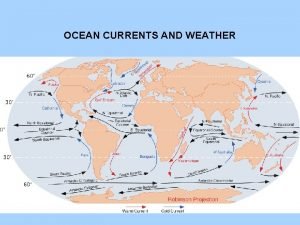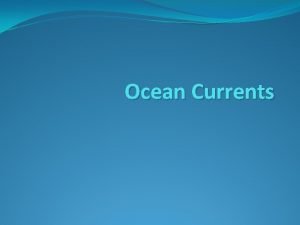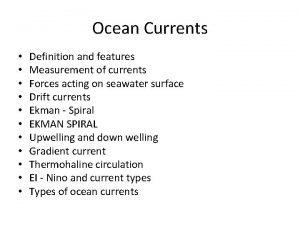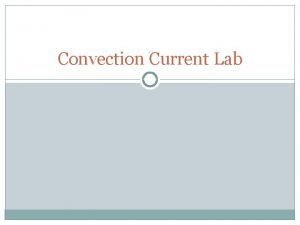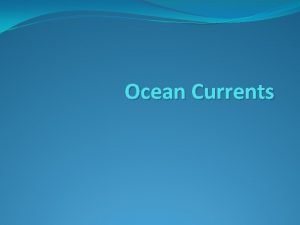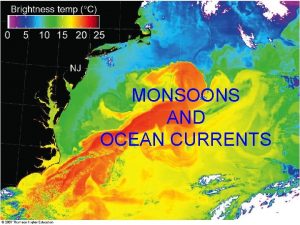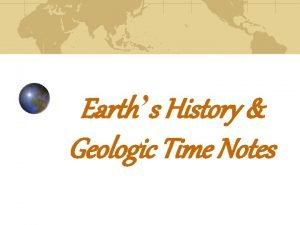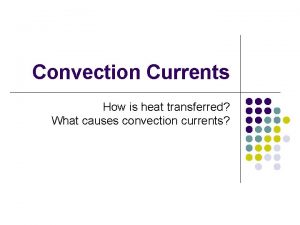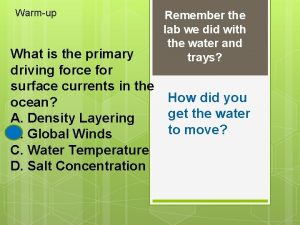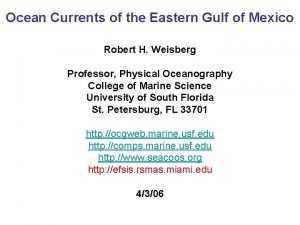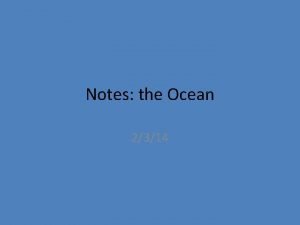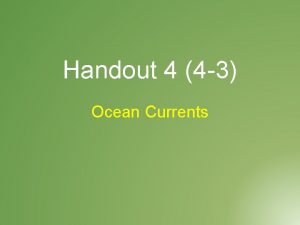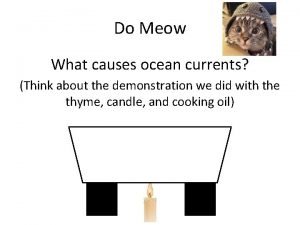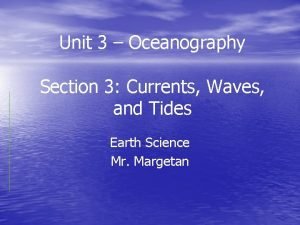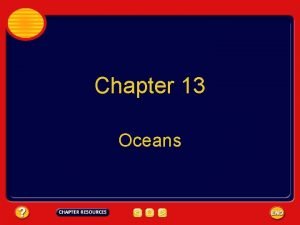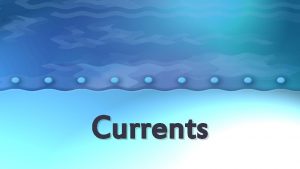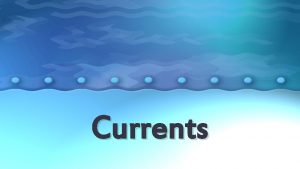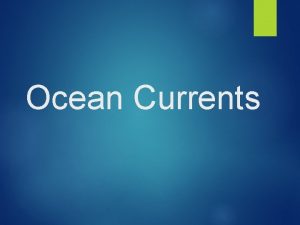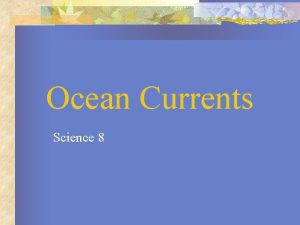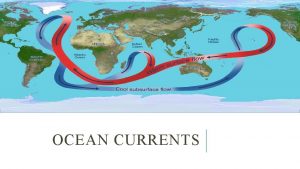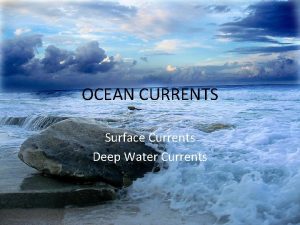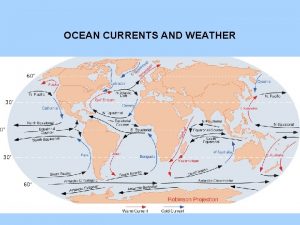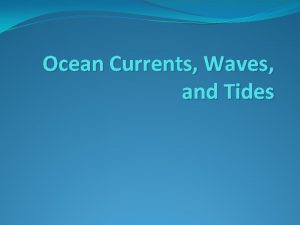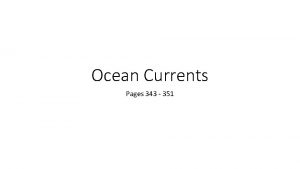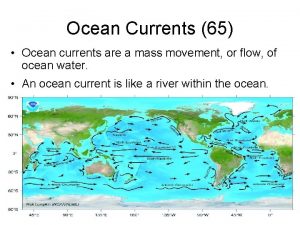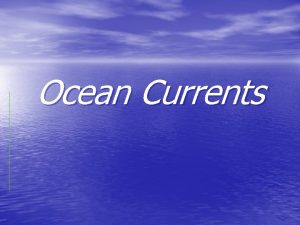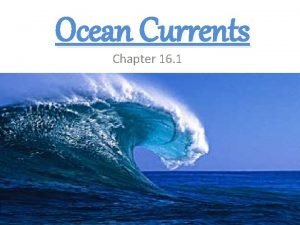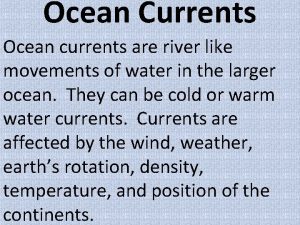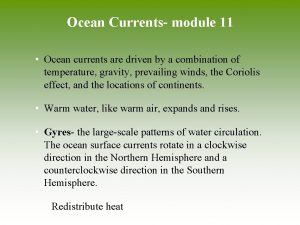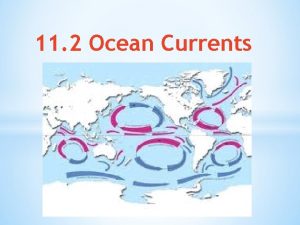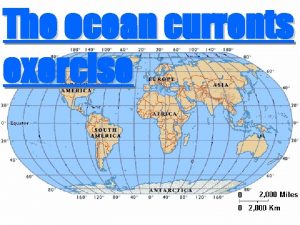Ocean Currents Key Ocean Currents When poets and





















- Slides: 21

Ocean Currents Key

Ocean Currents When poets and storytellers speak of the ocean they are often struck by its CONSTANTrestless motion, from the rolling ____, deep of the open sea to the ____ CRASHING coastal surf. Even the most casual observer is impressed by the swirl of _____ TIDES or the march of waves against the shore. But few note the silent, subtle passage of CURRENTS ____. Yet the power of currents to CONTROL move and _______ the seas is unmatched.

STREAMSof Currents are cohesive _______ seawater that circulate through the oceans. Some are short-lived and SMALLwhile others are vast flows that _____, CENTURIES take ____ to complete a circuit of the globe. (The Gulf Stream Current, which shows up in this temperature coded satellite image as a broad dark orange swath, has followed this course through the North Atlantic for millennia. )

SMALLeddy currents In contrast, the ______ that spin off the Gulf Stream die out FEW within a ____ months. WIND _______, Currents are caused by ____, GRAVITY and variations in _______ in WATER DENSITY different parts of the ocean. There are two distinct current systems in the oceans–____ circulation, which SURFACE stirs a relatively thin ______ layer of the UPPER sea, and ____ circulation, which DEEPthe deep-sea _______. sweeps along FLOOR

The dominant pattern of surface circulation is the GYRE well-organized, roughly _______ flow. _______–a CIRCULAR FIVE spin in subtropical waters, ____ enormous gyres two in both the Atlantic and Pacific Oceans, and one in the Indian Ocean. Smaller polar gyres stir the northern Atlantic and Pacific. One surface current circles ____ around _____. ANTARCTICA ENDLESSLY These gyres are made up of currents set in WINDS motion by _____ and ______, and steered by the GRAVITY placement of the continents and the _______ of ROTATION the Earth. ____ is the most important cause of WIND SURFACE ____ currents. When strong, sustained winds blow across the sea, _______ drags a thin FRICTION layer of water into motion.

TOPMOST layer of the The movement of the very _______ sea pulls on the water just beneath, which then in turn UNDER starts the layer _______ it moving. Energy from the wind is quickly dissipated, so wind-driven currents SLOW _______ down with _______, and finally die out. DEPTH within a few hundred meters of the surface. Surface currents are also triggered by ______. The GRAVITY top of the sea is not flat but has broad _________ and _____. Where currents HILLS converge or run into a continent, VALLEYS water ______ up. The major ocean gyres circle around a low mound a meter. PILES or so high. And in summer, intense sunlight can _______ and expand seawater, HEAT by several centimeters _________ the surface RAISING in the tropics.

Currents run down these gentle slopes under the gravity ________ and pull of ________ start water moving, but the Winds gravity currents that form don't flow parallel to the wind or straight down the steepest surface. Instead, the currents move at an ________ to the angle them–a phenomenon called force that generates the _________. Coriolis Effect The Coriolis Effect occurs because the earth's surface ________ faster at the equator rotates than at the poles. It influences the paths of moving objects that are only loosely in contact with the ground, from ______ to currents ______ to _________. winds airplanes

higher When objects move towards _______, slower moving latitudes, they outpace the rotation of the surface, and seem to veer toward east (If this plane left Miami heading the ______. straight at Chicago, it would miss its target unless it corrects for the Coriolis Effect. ) lower When objects move toward _______, faster moving latitudes, they lag behind the rotation of the surface. (This plane from Valparaiso veers toward the west and misses its destination of Santa Cruz by not adjusting for the Coriolis Effect. ) The Coriolis deflection is to the right in the _______ northern ______ left hemisphere, and to the _______ in the southern hemisphere. ___________

The movements of currents are also shape constrained by the _____ of the ocean basins. When a current runs into a turn aside. The continent, it must _____ wind gravity, complex interplay between ____, Coriolis_____, Effect ______ and topography determines shape of the ______, size, location ______, and direction the surface current gyres. (For example, consider this North Atlantic gyre. Like all the subtropical gyres, it is triggered by 2 of Earth's prevailing winds–the trade winds and the westerlies. )

The trade winds start a current that is turned _________ by the Coriolis Effect into a westward flow along the equator. The Equatorial Current gets _________ and warmer as it travelswarmer across the tropics. On the other side of the gyre, winds known as the westerlies, combined with the Coriolis deflection, push midlatitude water to the ______. east Called the North Atlantic Current, this flow loses ______ to the atmosphere. heat The eastern and western currents of the gyre begin where the equatorial and mid-latitude currents are __________ by land. blocked

On the Atlantic's western boundary, the Gulf Stream moves away from the equator and flows north. The Gulf Stream is the strongest ________, deepest, and fastest part of the gyre, and it transports an enormous amount of heat ________ toward the poles ________.

Finally, the slow and very shallow Canary Current runs south along the eastern edge cold of the Atlantic, carrying ____ water to the equator to complete the gyre. A single trip 10 around this circuit takes about ____ years. Although the gyres dominate, a number of other currents also make important contributions to surface circulation. For example, the very warm Equatorial Countercurrent, which flows eastward, can help trigger the unusual _______pattern called El Nino. weather

A much colder flow, called the Labrador Current, travels along the west side of Greenland. This icebergs current is notorious for flushing ______, including the one that sank the Titanic, into the heavily traveled North Atlantic shipping lanes. Many surface currents - the ones with names have been in constant motion for ______. millennia Other currents are temporary–longshore, rip, and upwelling currents only run in certain seasons or weather conditions. Longshore currents flow along _____ coastlines when waves run into the shore at an ______. They bulldoze great volumes ofangle sand along the shore, causing beaches _________ to disappear and harbors to fill in.

Rip currents form where obstacles channel water away _____ from the shoreline. Many an unwary swimmer and beachcomber has been swept out to sea after stumbling into a rip. winds push surface water away Upwelling occurs when _______ from the shore, and deeper water rises to fill the gap. nutrients These cold currents bring ______ to the surface and stimulate high plant and animal productivity. Deep-water circulation has a scale, pace, and power very different from surface circulation. Deep currents twist together into continuous a _____ stream that loops through ____ the oceans, all the global conveyer belt. With a volume more than called 16 _____ times the combined flow of all the world's ______, the conveyerrivers belt slowly but steadily ____ one ocean into another, and over the course of _______ years, turns empties 1, 000 the water in them upside down.

This vast, global circulation is driven by density _____ variations in the ocean. Sometimes called thermohaline circulation because it depends on _______ temperature and _______ salinity ______ , the conveyer begins on poles the surface of the sea near the ______. There, the water gets very cold, chilled by low air temperatures to freezing and below. saltier because when sea Polar seawater also gets ______, behind. As seawater gets ice forms, the salt is left ______. increases colder and saltier, its density _______ , and it starts sink the bottom. Surface water is pulled to _____ toward replace in to _______ the sinking water, and in its turn, salty eventually becomes _______ and _______ cold to sink. Thus, a current begins. enough

The conveyer belt begins at the surface of the Atlantic where great amounts of water North _____ cool and sink off the coast of ______. Greenland Hemmed in by the continents, this new deep water can only flow _______, past thesouth equator, all the way to the far ends of _______ and South Africa As the current travels around the edge America. fresh of Antarctica, ______ streams of cold water sink into and ____ the conveyer belt. recharge Two sections split off and turn northward, one into the ______ Ocean, the other into the Pacific. Indian Both these currents ______ up and become less and less _____ as they travel, warm enough that they densethe surface. eventually rise back toward

Drawn by the inexorable pull of the conveyer belt, these now warm waters loop back the way they came return and eventually _______ to the North Atlantic to begin the long journey all over again. Global Impact Currents are an integral and dynamic part of the world's oceans–they help determine the behavior characteristics and ____ of seawater, and the life distribution and abundance of marine _____. But currents are surprisingly important to landlocked creatures like us as well because they partially climateand govern the regulate the global ____ fishing grounds. productivity of _____

rise of deeper water to the Upwelling, the ____ surface, occurs only on ____10% of the ocean. But that small area makes up _____ of the half world's fisheries. The cool, _______-_____ nutrient filled currents support water in upwelling blooms of algae and seaweed, the ____ of Food chain the _____base for many clams, crustaceans, and fish. Herring, anchovy, and sardines, three of most the ______ widely harvested fish, are especially concentrated in upwelling zones.

Such sea life is an increasingly large component food supply. Currents play an of man's _____ climate important role in the Earth's _______ system. Overall, ocean currents moderate the planet's temperatureextremes. _____ Warm ______ flows, like the heatfrom the western boundary currents, carry ____ poles Coldsuch as the tropics toward the _____flows, eastern boundary currents, bring cooler low On a regional temperatures to ____ latitudes. scale, some areas are even more strongly affected. Because Western Europe is bathed in warm waters and winds coming east across the Atlantic, its climate is much _______ andwarmer milder than other areas at the same latitude, such as northern ____ & Alaska. Canada

Although the ocean currents that affect climate are large and vigorous, scientists are beginning to suspect that they are surprisingly easy ____ to disrupt. It is possible that global warming _______ could severely alter ______ current at least in the short term. patterns, rainfall If there is more ______ in the North Atlantic, melting and significant _____ of glacial and sea ice, a layer of warm fresh water could form at the sea ______. This surface layer could block the formation and _______ of sinking cold salty water there, and turn ___ the global off conveyer belt.

Once the conveyer belt, and its northward pull on warm surface currents, shuts down, average temperatures in much of Europe would plunge _______ F. o 10 -20 Unlike many other causes of climate change, catastrophic ______ due to the cooling loss of the global _______ belt could be conveyer rapid or quite _______, taking just a few years _____. decades
 What is a deep current
What is a deep current Chapter 15 ocean water and ocean life wordwise answer key
Chapter 15 ocean water and ocean life wordwise answer key Ocean currents waves and tides
Ocean currents waves and tides Ocean currents and weather
Ocean currents and weather Current
Current Surface current definition
Surface current definition Convection currents in the ocean
Convection currents in the ocean Brainpop ocean currents
Brainpop ocean currents Midnight zone
Midnight zone Coriolis force effect on ocean currents
Coriolis force effect on ocean currents Ocean currents
Ocean currents Ocean currents project
Ocean currents project What causes convection currents in earth's mantle
What causes convection currents in earth's mantle What is the primary driving force of surface ocean currents
What is the primary driving force of surface ocean currents Rubber ducks ocean currents activity
Rubber ducks ocean currents activity Ocean currents gulf of mexico
Ocean currents gulf of mexico What are ocean currents
What are ocean currents Surface ocean currents
Surface ocean currents What are ocean currents
What are ocean currents Factors affecting climate
Factors affecting climate Ocean currents
Ocean currents Cold peruvian current
Cold peruvian current



